Destination: Lake St. Clair/Windsor, Ontario
Enjoy a day of stellar smallmouth fishing on Lake St. Clair and then hop over to historic Windsor for an unforgettable cultural adventure
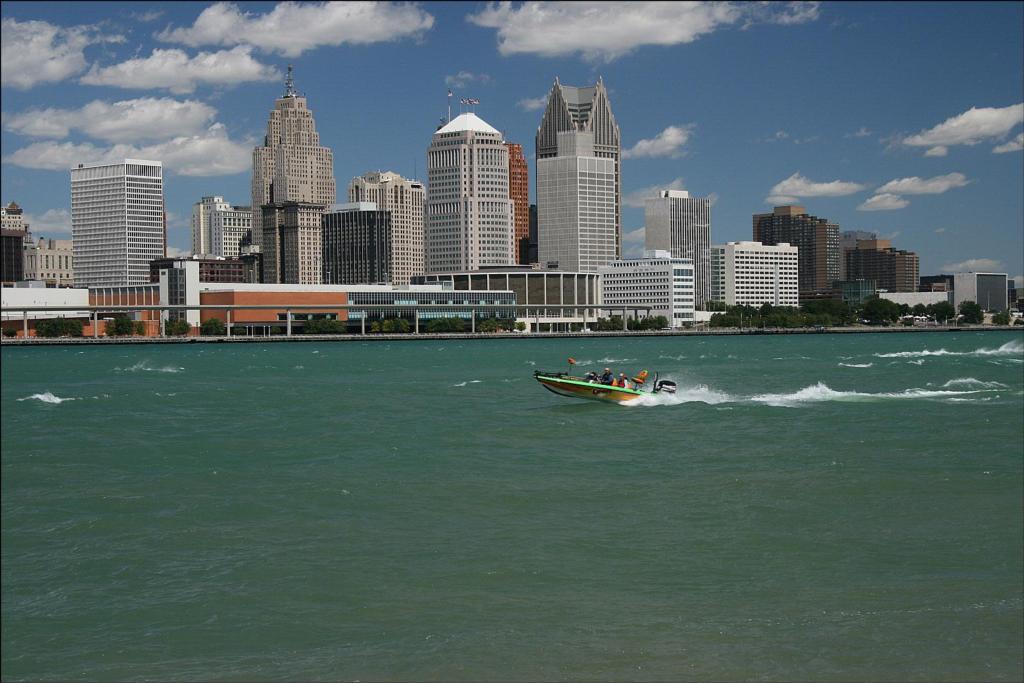
(Editor’s note: The following article orignally ran April 8, 2009, on FLWOutdoors.com)
It was during a Stren Series Northern Division event on the Detroit River in September 2007 when I overheard fellow Floridian Matt Greenblatt phoning his girlfriend to describe his first visit to nearby Lake St. Clair: “This lake is so good, I would drive up here backwards to fish it again!”
Indeed, the lake named for General Arthur St. Clair – first governor of the Northwest Territory – seldom fails to impress. Essentially a shallow bowl with an average depth of 10 feet and a manmade channel dropping to over 20 feet, St. Clair abounds with shiners, perch and crayfish, along with gobies – an invasive species that aggravates environmental managers, but delights brown bass.
“Lake St. Clair is an extremely fertile, diverse fishery with a strong forage base and a huge population of smallmouth,” said local guide and tournament angler Doug Cummings. “I think the fact that it’s a relatively shallow fishery for most of the season makes it easy to fish, too.”
Like a Hobbit among giants, St. Clair’s 460-square miles appear minute in the Great Lakes region. Nevertheless, this dynamic fishery consistently cranks out the big catches – both in terms of numbers and individual fish. There’s no denying the greater overall potential found in nearby Lakes Erie and Huron, but the spunky St. Clair more than holds its own.
Put in your time and 3- to 4-pound smallies come with regularity. Fish the lake hard for consecutive days and a 5-plus-pound catch is probable while 6-pounders are easily doable as well. If you’re lucky, you may even hook a 7-pounder. Respectable numbers of largemouth, along with pike, muskie, walleye, crappie and yellow perch enhance the fishery as well.
Lake St. Clair facts
Bordered by Michigan and Ontario, Canada, Lake St. Clair shines as one of North America’s top smallmouth destinations. Nestled between neighboring nations at a truly unique geographic location (see “Whimsical Windsor” below), the lake links to Huron via the St. Clair River at its north end and Erie through the Detroit River (south end). Continuous flushing keeps St. Clair fresh and fertile, while its tucked-away location offers respite from windy weather when life on the Great Lakes isn’t so great.
With the St. Lawrence Seaway cutting through its western half and roughly dividing U.S. and Canadian waters, St. Clair’s bottom ranges from lots of sand in the north end to a healthy supply of rocks along the southern shore. Break lines, gravel, sandbars and weed beds complete the picture.
Marshall, Mich. pro Ben Felton has seen 100-fish days punctuated by smallies over 6 1/2 pounds. His advice: Stay close to current and cover.
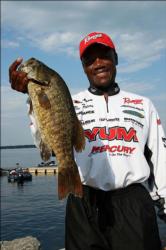 “Areas off the main channel where the fish can still feel the effects of the shipping-channel current seem to produce consistently,” he said. “I fish on either side of the channel, as far as two miles away, in the `bowl’ of the lake where the natural depth reaches about 18 feet. I look for isolated weed beds in this zone and pay close attention to those thick beds that sit away from other larger expanses.”
“Areas off the main channel where the fish can still feel the effects of the shipping-channel current seem to produce consistently,” he said. “I fish on either side of the channel, as far as two miles away, in the `bowl’ of the lake where the natural depth reaches about 18 feet. I look for isolated weed beds in this zone and pay close attention to those thick beds that sit away from other larger expanses.”
Canada prohibits bass fishing until the fourth Saturday in June. Michigan allows catch-and-release bass fishing from the last Saturday in April through the third Saturday in June, followed by an open season that runs through year’s end. Bass season closes Nov. 30 in Canadian waters. Both sides produce throughout the season, but the warmer months find Cummings spending more time near the maple leaves.
“You could fish U.S. waters all season and have an outstanding year, and the same could be said for Canadian waters,” Cummings notes. “But as the season progresses (and the lake warms), there is traditionally a better bite and stronger patterns to fish in Canadian waters, both in the main lake and in the channels around Walpole Island (north end). I think this is because of the inflow of cool water from the St. Clair River coming down the channels that dissect Walpole Island on the Canadian side.”
Expect dependable action along the south shore from Askins Point just outside the Detroit River to the Belle River area. The Belle River Hump, a large rocky structure jutting six miles into the lake sports attractive smallmouth habitat, as do humps adjacent to “The Firecracker” – a red channel marker located near the mouth of the St. Clair River.
In Michigan waters, Cummings likes Muscamoot Bay and the shoreline from Metro Beach down to the Detroit River. The waters off St. Clair Shores (also known as “The Mile Roads” area) produce well in the early season. Throughout the lake, smallies will move shallow during their spring spawn, retreat to deeper habitat through summer, return to the shallows for fall and then winter back in deep water.
Here’s a snapshot of common seasonal tactics.
Spring fling
Dragging tubes is the go-to tactic throughout the St. Clair smallmouth season. Slow, hopping retrieves are usually best, but aggressively “cracking” or “snapping” tubes on rocks will wake up lethargic fish. Felton likes green pumpkin colored tubes and fits them with ¼-ounce round-head jigs, which allow his baits to sink where he casts without gliding away on the descent.
Despite his faith in tubes, Cummings notes the inherent time commitment.
“This is by far the most popular technique and takes a lot of fish all year long. But if you’re new to the lake, or fishing an unfamiliar area, dragging a tube is a slow way to find out if there are fish in the area. Often times you could be missing out on more or bigger fish by dragging a tube all day.”
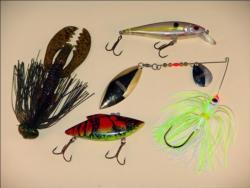 Preferring an active approach, Cummings fishes a suspending jerkbait like the XCalibur Xt3 Twitch Bait (ghost or pearl melon color) with a slow sweep/pause retrieve to cover a lot of water and judge fish activity. He also runs a small crankbait like a Bomber BD4F or BD5M Fat Free Shad in 4-6 feet of water. When calm, clear days find smallmouth spooking away from noisy, flashy baits, Cummings rigs a 4-inch curly tail grub on a 1/8- or 3/16-ounce darter style jighead and swims it slowly. If the fish won’t chase anything, he’ll fish a tube or drop-shot.
Preferring an active approach, Cummings fishes a suspending jerkbait like the XCalibur Xt3 Twitch Bait (ghost or pearl melon color) with a slow sweep/pause retrieve to cover a lot of water and judge fish activity. He also runs a small crankbait like a Bomber BD4F or BD5M Fat Free Shad in 4-6 feet of water. When calm, clear days find smallmouth spooking away from noisy, flashy baits, Cummings rigs a 4-inch curly tail grub on a 1/8- or 3/16-ounce darter style jighead and swims it slowly. If the fish won’t chase anything, he’ll fish a tube or drop-shot.
When Felton locates a school of spring fish, a patch of hard bottom or a rock pile, he works the area with creature baits on football jigs and Carolina rigged lizards. During the pre-spawn, he’ll use a Yum Money Minnow to entice big fish roaming shallow flats.
Summer sensation
As July ushers in the summer patterns, anglers may find schools of smallmouths relating to offshore humps and weed beds as deep as 18-20 feet. Cummings locates these fish with a jerkbait or a deep diving crankbait. If the fish hug the bottom, they’ll see a tube or a drop-shot.
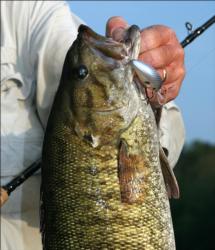 The mouths of the St. Clair River channels (north, middle and south) also produce strong warm-season action as smallies chase baitfish that seeks the cooler river water. Cummings fishes spinnerbaits or lipless crankbaits around area weed beds, current eddies and bottom depressions in the 3- to 5-foot flats adjacent to the channel drops. The natural look and subtle action of a soft-bodied swimbait often does the trick when shallow fish are spooky.
The mouths of the St. Clair River channels (north, middle and south) also produce strong warm-season action as smallies chase baitfish that seeks the cooler river water. Cummings fishes spinnerbaits or lipless crankbaits around area weed beds, current eddies and bottom depressions in the 3- to 5-foot flats adjacent to the channel drops. The natural look and subtle action of a soft-bodied swimbait often does the trick when shallow fish are spooky.
Felton looks for isolated weed clumps that sit on marl bottom away from larger beds.
“Many times, a thick isolated clump may hold a small group of above average fish. When smallmouths are still in the 10- to 12-foot range, jerkbaits – both soft (Yum Houdini Shad) and hard (Excalibur twitch baits) – can be deadly around new weed growth. I also like to use a green pumpkin tube as a clean-up bait.”
As water temperatures rise, Felton searches for deeper weed clumps in 14-16 feet. If lake clarity permits, he’ll make pinpoint casts with a tube or drop-shot. When the fish seem to be in a roaming mode, he’ll throw Bomber crankbaits – a proven big bite tactic.
Fall brawl
As autumn brings smallies back to the St. Clair shallows, Cummings transitions to a quick-hit game plan that targets active schools of fish.
“This is the time for covering water and fast retrieves. Just put the trolling motor down and start casting until you find them. You could fish down 100 yards of shoreline and only get a bite or two, then all of a sudden get 10 on 10 casts.”
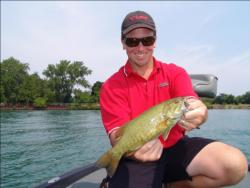 Favoring areas of scattered rocks and weeds in 3-7 feet on the lake’s south shore, Cummings attacks the fall action with an XCalibur Xr50 Rattlebait, XCalibur Xt3 Twitch Bait and a Yum Houdini Shad. For numbers, he said, the most productive fall bait is usually a lipless crankbait.
Favoring areas of scattered rocks and weeds in 3-7 feet on the lake’s south shore, Cummings attacks the fall action with an XCalibur Xr50 Rattlebait, XCalibur Xt3 Twitch Bait and a Yum Houdini Shad. For numbers, he said, the most productive fall bait is usually a lipless crankbait.
Running spinnerbaits along the edges and over the tops of weed beds is one of Felton’s favorite fall tactics. “The fish will tend to be grouped up so the key is to find a school. Once action slows, a tube will be an excellent choice as a follow-up bait.
“In late fall and winter when air temperatures plummet to the 30s and 40s, slowly dragging a tube is an excellent technique for big smallies fattening up for winter. Once fish return to deeper water, I like to use a blade bait or spoon to entice more lethargic fish into biting.”
Whimsical Windsor
Between fishing trips, make time to visit a true gem of Canadian majesty – Windsor, Ontario. Facing Detroit’s skyline from the south shores of the Detroit River, Windsor marks the only border crossing where entering the mainland United States from Canada involves traveling north. Crossing the Ambassador Bridge, or traversing the Detroit-Windsor Tunnel a couple miles to the east, is like passing through some magic portal that leads to a land of charm and fascination.
Tidy waterfront parks adorned with immaculate gardens, sculptures, monuments and ample biking/walking paths can easily consume a well-spent day, but Windsor offers much more. Named for a famous castle in Berkshire, England, Windsor highlights its historical and cultural elements from early settlements and military moments to the Underground Railroad’s Canadian havens and dresses the scene with a clear attention to aesthetic accouterments. A vibrant City Centre boasts fashion boutiques, trendy cafes, traditional eateries and an immaculate casino complex sporting the full spread of fine dining, luxury suites and games of chance.
 A balanced blend of style and substance, Windsor and its surrounding communities offer a safe and visitor-friendly environment whose sensible layout and convenient roadways facilitate convenient travel. About 30 minutes south of the metro area, the sleepy town of Amherstburg holds several 18th Century homes, the North American Black History Museum and the Fort Malden National Historic Site, where live military reenactments showcase Ontario’s military history.
A balanced blend of style and substance, Windsor and its surrounding communities offer a safe and visitor-friendly environment whose sensible layout and convenient roadways facilitate convenient travel. About 30 minutes south of the metro area, the sleepy town of Amherstburg holds several 18th Century homes, the North American Black History Museum and the Fort Malden National Historic Site, where live military reenactments showcase Ontario’s military history.
Near the water, tall maples rustle in the breeze, as the shady gazebos, sculpted flower beds, cozy benches, and vine-covered trellises of King’s Navy Yard Park offer a pleasant culmination to an Amherstburg visit. Once the base and supply depot for Britain’s Provincial Marine on Erie and Huron, the park now offers an enjoyable spot to rest and relish memories of those St. Clair smallies.
For additional travel details, visit visitwindsor.com.
Note: Complete access to Lake St. Clair requires fishing licenses for Michigan, Ontario and the Walpole Indian Reservation waters. For Michigan fishing regulations, visit www.michigan.gov/dnr/. For Canadian regulations click here. For guided trips, contact Doug Cummings at (586) 212-1076 or [email protected]